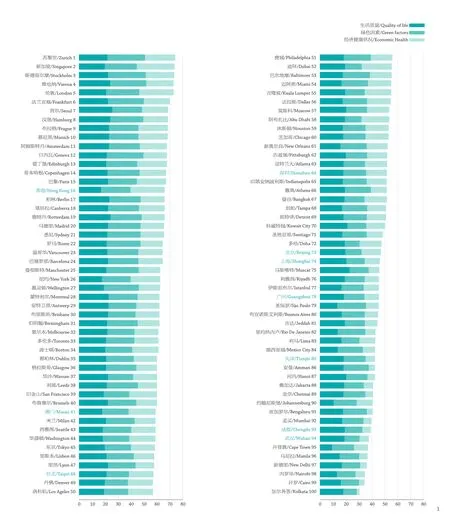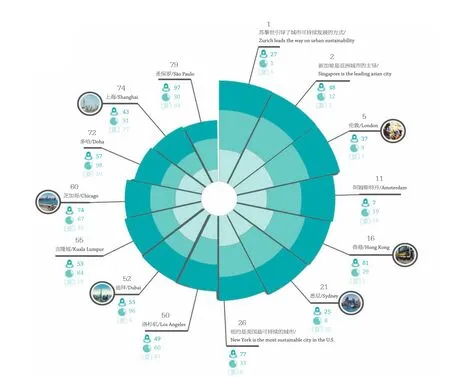拓展可持续性的定义
约翰·巴顿/John Batten
尚晋 译/Translated by SHANG Jin
拓展可持续性的定义
Widening the Definition of Sustainability
约翰·巴顿/John Batten
尚晋 译/Translated by SHANG Jin
在凯迪思,我们相信正如生命中的一切,平衡是关键。当我们谈论可持续性时,很多人都认为它仅仅指环境问题。但我们的定义要广泛得多,它包含三大支柱:保护地球、人和利益。我们相信一座可持续的城市会平衡居民的直接需求,又不损害未来的需要。
城市是围绕居民运转的,而可持续性终将提高人们的生活质量。城市居民的需求范围很广,包括营养、住房和安全等生存条件,教育和就业机遇,以及娱乐与文化艺术设施。建筑、交通网络和步行道等城市建成环境,在规划和建设重视居民的生活体验时就会实现最佳运转。让城市为永久居民进行投资、发展、演变并最终成为更美好的家园,将推动它的可持续性和竞争力更上一层楼。
城市可持续性日趋以各种新途径现实。我们相信真正理解城市可持续性的最佳途径是从人、地球和利益的角度综合各种属性,形成关于每个地方及其可持续性排位的整体观。唯其如此,我们才能清楚一座城市是否可持续。
最早的凯迪思可持续城市指数是同经济商业研究中心在2015年发布的。它根据三大支柱,从每个地方在社会、环境和经济方面对居民的关怀程度评估了全球50座城市。2016年第二版指数在评估城市体验中人的方面上更进一步。我们建立了一套更完善的数据组,更全面地标示可持续性。我们还将指数在全球覆盖的城市增加到100座,既有发达城市也有新兴城市。我们使用了32项不同指标,并给每一项的可持续性进行指标排名。城市会在可持续性的三大支柱上得分,城市的总分等于这三个次指数的平均值。
尽管位置、气候和资源条件等地理因素都会给同类项对比带来问题,但在对可持续性至关重要的三大方面,这份报告能让城市衡量其总体状况,找到对比的基准,向排名更高的城市学习,并采取行动保持未来的发展。

三大支柱/The three pillars
次指数“人”衡量社会状况,包括生活质量、健康评级(预期寿命和肥胖)、教育(识字率和大学)、收入不均、工作生活平衡、扶养比、犯罪、住房和生活成本。这些指标可以大致认为体现了“生活质量”。/The People sub-index measures social performance including quality of life, rating health (life expectancy and obesity), education (literacy and universities), income inequality, work-life balance, the dependency ratio, crime, housing and living costs. These indicators can be broadly thought of as capturing 'quality of life'.
次指数“地球”从能耗与可再生能源比率、城市绿色空间、回收与堆肥率、温室气体排放、自然灾害、饮用水、卫生与大气污染等方面对城市进行排名。这些指标可以大致认为体现了“绿色因素”。/The Planet sub-index ranks cities on energy consumption and renewable energy share, green space within cities, recycling and composting rates, greenhouse gas emissions, natural catastrophe risk, drinking water, sanitation and air pollution. These indicators can broadly be thought of as capturing 'green factors'.
第三大支柱是“利益”,该次指数从商业角度进行考查,它结合了交通基础设施(铁路、航空和交通拥堵)、经商便捷、旅游业、人均GDP、城市在全球经济网络中的重要性、移动和宽带通信方面的连通性以及就业率等。这些指标可以认为大致体现了“经济健康状况”。/The third pillar is Profit and this sub-index examines performance from a business perspective, combining measures of transport infrastructure (rail, air and traffic congestion), ease of doing business, tourism, GDP per capita, the city's importance in global economic networks, connectivity in terms of mobile and broadband access and employment rates. These indicators can broadly be thought of as capturing 'economic health'.

1 100个城市的3大支柱数据/100 cities data of 3 pillars

2 世界各城市关于可持续性的简图/A snapshot of urban sustainability around the world(1,2图片来源/Source: http://www.arcadis.com/en/global/our-perspectives/ sustainable-cities-index-2016)
欧洲城市名列前茅
对比结果是耐人寻味的。没有一座城市重复出现在三个次指数的前10位。除了新加坡和首尔,排名前10的城市大多数在北欧和中欧——前10位中有3个都来自德国。指数排名的后半段包括了所有的中国大陆城市,之后大多是拉美城市。欠发达的亚太大城市还要靠后一些,指数中最不发达的主要是印度和非洲城市。所以,经济发达的城市基本靠前,而经济处于兴起和发展阶段的趋向集中在底部。
无论城市还是国家,可持续经济的内在矛盾在于后世的福祉是否受到今天生活方式的威胁。目前,所有发达的经济活动都因大量排放温室气体,没有充分回收我们所用的有限资源,耗尽了不可再生能源,而威胁到未来的生活水准。
聚焦大中华区
香港指数位居第16位,而在中国大陆城市中,深圳排名第64位,北京第73位,上海第74位,广州第78位。接下来,成都第93位,武汉第94位。显然,中国城市和世界其他地方一样在努力实现可持续性三大支柱的平衡。例如,香港在利益的次指数上排名第2位,但在人的次指数上是第81位。向北,上海在地球的次指数上仅列第91位,而在人的次指数上是第43位。城市在不同方面得分相去甚远的极端情况表明可持续性是很难实现的。为了保证它们的未来,中国的规划机构需要考虑平衡,避免拉低可持续性水平。
新机遇在呼唤
指数表中的所有城市都处在发展的不同阶段,有些在可持续水平上要胜过其他。重要的是,凯迪思可持续城市指数的目标不是建立精英城市的层级或“点名批评”,而是为了标明存在机遇的各个方面。所有的城市都在各自的道路上不断前进,提高经济和环境上的可持续性并造福于民。
随着世界越来越依赖城市中心,我们希望城市领导人和各行业将它作为判断工作轻重缓急的重要手段,以及为全民利益实现城市可持续性的途径。可持续性终将改善居民的生活质量。城市居民的需求十分广泛,包括营养、住房和安全等生存条件,教育和就业机遇,以及娱乐与文化艺术设施。建筑、交通网络和步行道等城市建成环境,在规划和建设重视居民的生活体验时就会实现最佳运转。我们希望这份报告能促进城市领导人在让充分发展城市特色的方式上作出清晰的展望。
自然资源条件是至关重要的,而它对于维持人与利益之间的平衡更是如此。例如,同清洁的水和空气一样,绿色空间对于城市已是愈发重要的条件和脱颖而出的因素。为此,各个城市都在制定创新方案来满足这种需求。城市已经开始同自然和谐共建,而不是破坏自然——中国正在推行的许多海绵城市项目就是极好的例子。城市中的自然资源正被纳入新空间的创造中,这会直接改善居民共同的生活质量,并招徕八方游客。
让城市为永久居民进行投资、发展、演变并最终成为更美好的家园,将推动它的可持续性和竞争力更上一层楼。
At Arcadis, we believe that like everything in life, balance is key. When we talk about sustainability, lots of people think that this only refers to environmental issues. Our definition however is much broader and covers three pillars: protecting the planet, people and profit. We believe that a sustainable city balances the immediate needs of its people without compromising the needs of tomorrow.
A city revolves around its people, and sustainability ultimately improves their quality of life. The range of people's needs in a city is broad, encompassing livelihood requirements of nourishment, housing and safety, education and vocational opportunities, recreational outlets and access to culture and arts. A city's built assets, such as buildings, transportation networks and pedestrian thoroughfares, perform optimally when planned and installed to accentuate the living experience of its people. Getting a city to invest, develop, evolve and, ultimately, be a better host for its permanent residents, will propel it to become more sustainable and competitive.
City Sustainability is increasingly accomplished in new and different ways. We believe the best way to truly understand the sustainability of a city is to amalgamate attributes from the perspectives of people, planet and profit to form a holistic view of each location and its position on the sustainability scale. Only then can we obtain a clear picture of how sustainable, or not, a city is.
The first Arcadis Sustainable Cities Index, published in 2015 with the Centre for Economic and Business Research (Cebr), assessed 50 global cities according to the three pillars and evaluated how well each location caters to its population socially, environmentally and economically. In 2016, the second edition of the index went deeper in assessing the people dimension of the urban experience. We created a more robust data set to provide a more comprehensive indication of sustainability and we increased the coverage of the Index to 100 cities, both developed and emerging, around the world. We used 32 different indicators to develop an indicative ranking of the sustainability of each. A city receives a score on each of the three pillars of sustainability and a city's overall score is equal to the average of the three sub-indices.
While geographical factors such as location, climate and access to resources all make like-for-like comparisons problematic, the report gives cities the opportunity to measure their overarching performance across these three areas, each vital for sustainability, to benchmark and learn from higher placed cities and take action to sustain future performance.
European cities dominate the top of the table
Te results make for interesting reading. No city appears in the top ten in all three pillars. With the exception of Singapore and Seoul, the top ten ranked cities are mostly from northern and central Europe– three of the top ten are in Germany alone. The lower half of the Index contains all of the mainland Chinese cities, with cities from Latin America mostly following. The less advanced Asia-Pacific metropolises are a little further down, with the leastdeveloped cities in the Index, predominantly those in India and Africa, finishing the Index. Therefore, cities in advanced economies are largely at the top while those in emerging and developing economies tend to cluster towards the bottom.
The tension inherent in a sustainable economy, be it a city or a country, is whether future generations' well-being is jeopardized by today's lifestyles. At present, all advanced economies put future standards of living at risk through high emissions of greenhouse gases, by not recycling enough of the finite resources we use and by depleting our non-renewable energy sources.
Greater China in focus
Hong Kong comes 16th in the index while out of mainland China cities, Shenzhen is 64th, Beijing is 73rd, Shanghai is 74th and Guangzhou is 78th. Further down, Chengdu is 93rd and Wuhan is 94th. It's clear that cities in China, like in many other parts of the world, are struggling to achieve a balance in the three pillars of sustainability. Hong Kong for example, is 2nd in the table on profit but 81st on the people sub-index. Heading north, Shanghai is down the table in 91st place on the planet sub-index but 43rd for people. These extremes, where cities have disproportionately low scores in some areas but higher scores in others, mean that sustainability is difficult to achieve. To future-proof themselves, planning authorities in China need to consider the need for balance to stop dragging down their sustainability levels.
New opportunities beckon
All of the cities in the Index are in various stages of evolution, some further along their sustainability journey than others. Importantly, the purpose of the Arcadis Sustainable Cities Index is not to create a hierarchy of elite cities or to 'name and shame' but to indicate areas of opportunity. All cities continue to make progress on their missions to become more sustainable economically, environmentally and for the good of their inhabitants.
As the world continues to become more reliant on its urban centres, it is our hope that city leaders and industry find this a valuable tool in assessing their priorities and pathways to urban sustainability for the good of all. Sustainability ultimately improves their quality of life. Te range of people's needs in a city is broad, encompassing livelihood requirements of nourishment, housing and safety, education and vocational opportunities, recreational outlets and access to culture and arts. A city's built assets, such as buildings, transportation networks and pedestrian thoroughfares, perform optimally when planned and installed to accentuate the living experience of its people. We hope this report encourages city leaders to develop a clear vision on how to evolve their city's characters to be the best possible version of itself.
Access to natural resources is critically important, but it is even more so to maintain a balance between people and profit. As well as clean water and air, for example, the availability of green spaces is becoming a more important requirement and a source of differentiation for a city. In response, cities are developing some innovative solutions to address this need. Cities are beginning to build with, rather than against, nature – a great example would be the sponge city projects happening in China. Te natural capital within the city is being incorporated to create new spaces that can make a direct contribution to the shared quality of life available to citizens and can attract visitors.
Getting a city to invest, develop, evolve and, ultimately, be a better host for its residents, will propel it to become more sustainable and competitive.
上海/SHANGHAI
总体排名/Overall ranking: 74

3 上海城市印象/Citi snapshot for Shanghai(图片来源/Source: https:// wallpapersafari.com/shanghai-hd-wallpaper/)

上海是中国重点门户城市之一。它一直是国际贸易、金融和商业的枢纽。它在凯迪思可持续城市指数上总体排名第74位,并在人的次指数排名上得分位居所有中国大陆城市之首。
上海在不断努力成为中国最具可持续性的城市之一。在它从国家的制造中心转变为知识、技术和创新中心的过程中,城市再生和创新枢纽将是其未来发展中的重要因素。随着张江和漕河泾的持续扩展和演变,这些开发区对上海的未来产生了重要影响。
上海的城市发展是由持续演变的交通系统支撑的。城市的25条地铁线中有13条已经建成运行。该地区还不断通过高铁和城市快轨拓展与长三角的交通连接。
随着迪士尼乐园的开放和其他娱乐混合功能区的开发,旅游也将成为上海城市发展的一大因素。浦东未来的增长将给城市带来更多休闲娱乐实施,使它成为上海持续发展演变的一个关键方面。
教育对于上海保证未来劳动力供给的质量十分重要。新开校的上海科技大学,加上同济和复旦等久负盛名的大学,使未来一片光明。
Shanghai is one of the key gateway cities into China. It has always been a hub for international trade, finance and business. It ranks 74th overall on the Arcadis Sustainable Cities Index and scores highest among all the mainland China cities on the people sub-index ranking.
With Shanghai continuing its quest to be one of the most sustainable cities in China, urban regeneration and innovation hubs will be important elements of its future development, as the city transforms itself from a manufacturing center to a knowledge, technology and innovation center for the nation. Zhangjiang and Caohejing developments play an important part in Shanghai's future as they continue to expand and evolve.
Shanghai's urban transformation is underpinned by an evolving transportation system. 13 of the city's 25 metro lines are completed and operational. Te region continues to evolve its transportation connectivity to the greater Yangtze River Delta with new high-speed rail and urban highway connections.
Tourism will also become a major element of Shanghai's urban transformation, with the opening of the Disney resort and other entertainment-related mixed-use developments. The future growth of Pudong will bring more resort and entertainment development to the city, making it one of the key aspects of Shanghai's continued growth and evolution.
Education plays an important role in Shanghai in ensuring the quality of future workforce supply. With the opening of the Shanghai Tech University, in addition to well-established universities such as Tongji and Fudan, the future is looking optimistic.
香港/Hong Kong
总体排名/Overall ranking: 16

4 香港城市印象/Citi snapshot for Hong kong(图片来源/Source: http:// www.filmexpos.com/wp-content/uploads/2016/05/HongKong-heroimage-CineAsia.jpg)

总体排名第16位的香港在利益的次指数上跻身第2位。凭借世界水平的基础设施、活力四射的经济和教育良好的人才,香港被尊为世界商业的一颗明珠是无足为奇的。
香港在地球的次指数上是亚洲名列前茅的城市(在大中华区位居第三)。它的公园和岛屿让人能够轻松享受大自然的乐园,不过它需要改善城市环境中开放空间的品质。
虽然地处台风区,但香港在相关的减灾措施方面是世界的佼佼者,并极少遭受重大破坏。
与全球其他城市的人的次指数相比,香港在工作生活平衡和贫富差距上面临艰巨的挑战。对于影响着青年和加速老龄化的人口的住房与社会基础设施问题,它必须找出解决之道。如果香港要为居民带来更光明、更可持续的未来,这些因素就必须成为城市的当务之急。这座城市非常安全,犯罪率很低。
随着其他亚洲城市日益繁荣、影响力扩大,香港面临着来自区域竞争对手越来越大的压力。至关重要的是,它必须与中国大陆的快速发展保持一致。城市规划应赋予它克服这些挑战的能力,并要以更快、连通性更好、更可持续的方式付诸实施。如果成功,它将稳稳地保住“亚洲世界城市”的桂冠。
With a ranking of 16th overall, Hong Kong scored strongly in second place in the profit sub-index. With a world-class infrastructure, vibrant economy and well-educated talent pool it's no surprise that Hong Kong is considered one of the world's best places to do business.
Hong Kong is one of Asia's leading cities (third in region) in relation to the planet subindex. Its parks and islands provide easy access to an extensive natural playground, though it needs to improve the quality of open space within the urban environment.
Despite being located in a typhoon zone, Hong Kong is a world leader in mitigating the associated risks and rarely suffers significant disruption.
Compared with its global peers in the people sub-index, Hong Kong faces significant challenges in work-life balance and the wealth gap. It has to find solutions to housing and social infrastructure issues affecting both its young and its increasingly aging population. Tese factors have to be among the city's top priorities if it's to ensure a brighter, more sustainable future for its people. Te city is extremely safe with low crime levels.
As other Asian cities grow in prosperity and dominance, Hong Kong is under increasing pressure from regional competitors and, critically, it has to maintain its relevance to China's continued development. The city's plan should enable it to rise to these challenges provided it's delivered in a faster, more connected and sustainable manner. If so, it will rightly maintain its mantle of 'Asia's World City'.
凯迪思/Arcadis
2017-03-05

